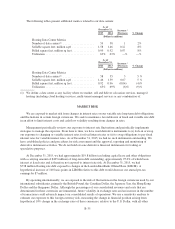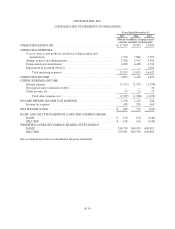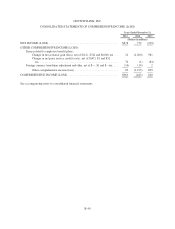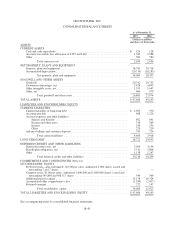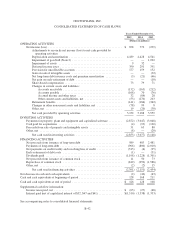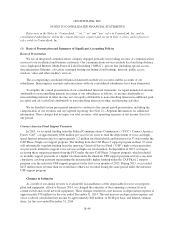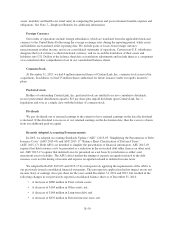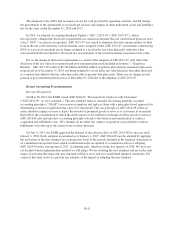CenturyLink 2015 Annual Report Download - page 153
Download and view the complete annual report
Please find page 153 of the 2015 CenturyLink annual report below. You can navigate through the pages in the report by either clicking on the pages listed below, or by using the keyword search tool below to find specific information within the annual report.Additionally, during the third quarter of 2014, we developed a plan to migrate customers from one of our
networks to another over a one-year period beginning in the fourth quarter of 2014. As a result, we implemented
changes in estimates that reduced the remaining economic lives of certain network assets. The increase in
depreciation expense from the changes in estimates was more than fully offset by decreases in depreciation
expense resulting from normal aging of our property, plant and equipment. These changes in the estimated
remaining economic lives resulted in an increase in depreciation expense of approximately $48 million and $12
million for the years ended December 31, 2015 and 2014, respectively. This increase in depreciation expense, net
of tax, reduced consolidated net income by approximately $32 million, or $0.06 per basic and diluted common
share and $7 million, or $0.01 per basic and diluted common share, for the years ended December 31, 2015 and
2014, respectively.
Summary of Significant Accounting Policies
Use of Estimates
Our consolidated financial statements are prepared in accordance with U.S. generally accepted accounting
principles. These accounting principles require us to make certain estimates, judgments and assumptions. We
believe that the estimates, judgments and assumptions we make when accounting for specific items and matters,
including, but not limited to, investments, long-term contracts, customer retention patterns, allowance for
doubtful accounts, depreciation, amortization, asset valuations, internal labor capitalization rates, recoverability
of assets (including deferred tax assets), impairment assessments, pension, post-retirement and other post-
employment benefits, taxes, certain liabilities and other provisions and contingencies, are reasonable, based on
information available at the time they are made. These estimates, judgments and assumptions can materially
affect the reported amounts of assets, liabilities and components of stockholders’ equity as of the dates of the
consolidated balance sheets, as well as the reported amounts of revenues, expenses and components of cash flows
during the periods presented in our other consolidated financial statements. We also make estimates in our
assessments of potential losses in relation to threatened or pending tax and legal matters. See Note 11—Income
Taxes and Note 14—Commitments and Contingencies for additional information.
For matters not related to income taxes, if a loss is considered probable and the amount can be reasonably
estimated, we recognize an expense for the estimated loss. If we have the potential to recover a portion of the
estimated loss from a third party, we make a separate assessment of recoverability and reduce the estimated loss
if recovery is also deemed probable.
For matters related to income taxes, if we determine that the impact of an uncertain tax position is more
likely than not to be sustained upon audit by the relevant taxing authority, then we recognize a benefit for the
largest amount that is more likely than not to be sustained. No portion of an uncertain tax position will be
recognized if the position has less than a 50% likelihood of being sustained. Interest is recognized on the amount
of unrecognized benefit from uncertain tax positions.
For all of these and other matters, actual results could differ materially from our estimates.
Revenue Recognition
We recognize revenue for services when the related services are provided. Recognition of certain payments
received in advance of services being provided is deferred until the service is provided. These advance payments
include activation and installation charges, which we recognize as revenue over the expected customer
relationship period, which ranges from eighteen months to over ten years depending on the service. We also defer
costs for customer activations and installations. The deferral of customer activation and installation costs is
limited to the amount of revenue deferred on advance payments. Costs in excess of advance payments are
recorded as expense in the period such costs are incurred. Expected customer relationship periods are estimated
using historical experience. In most cases, termination fees or other fees on existing contracts that are negotiated
in conjunction with new contracts are deferred and recognized over the new contract term.
B-45


